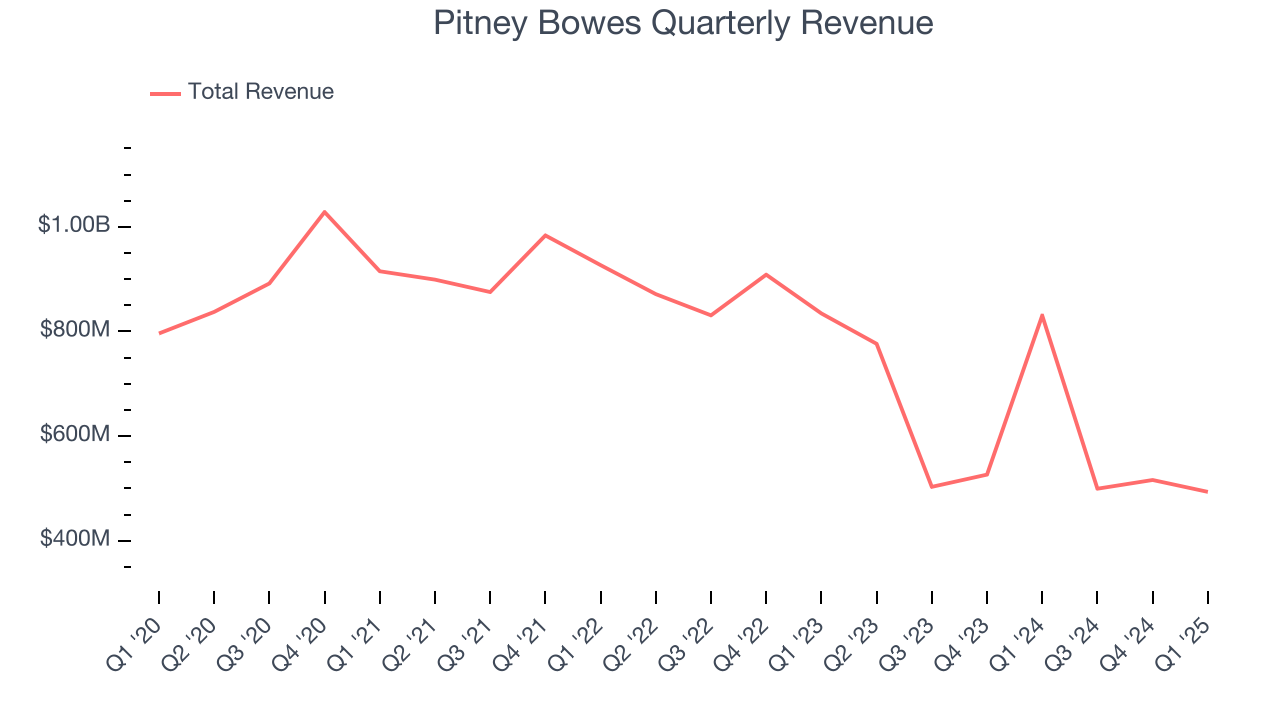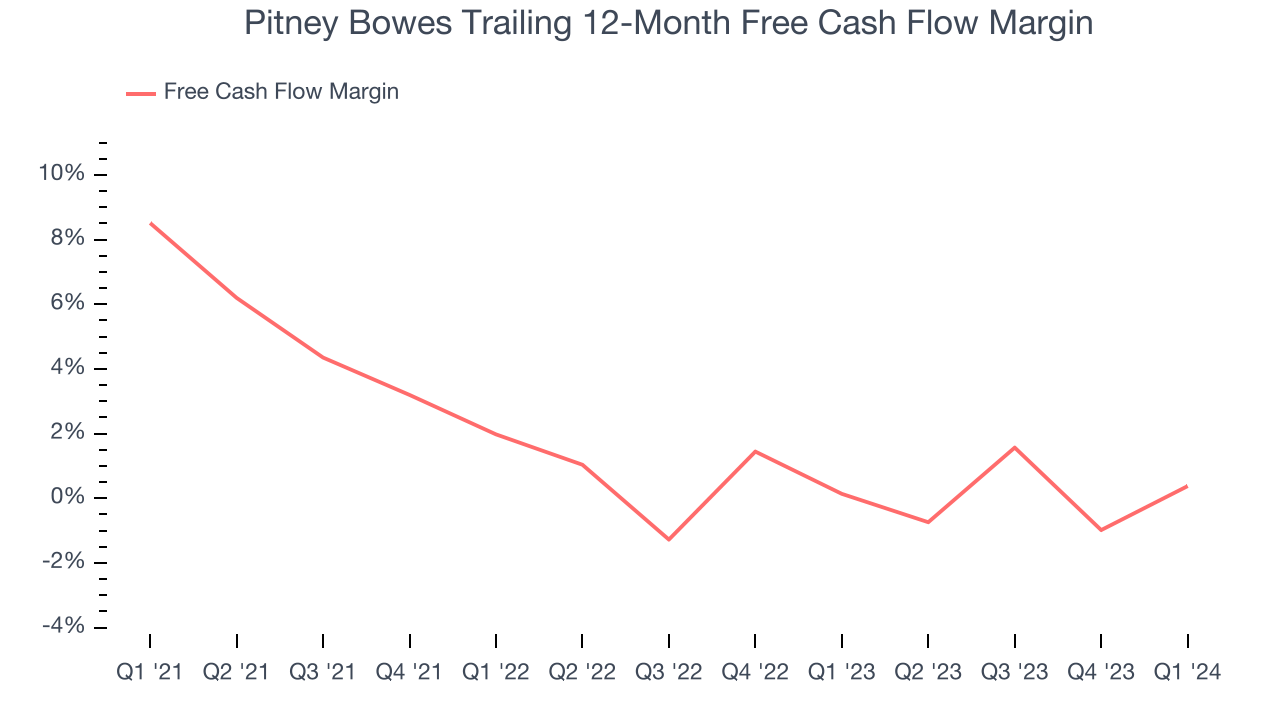
Pitney Bowes (PBI)
We aren’t fans of Pitney Bowes. Not only are its sales cratering but also its low returns on capital suggest it struggles to generate profits.― StockStory Analyst Team
1. News
2. Summary
Why We Think Pitney Bowes Will Underperform
With a century-long history dating back to 1920 and processing over 15 billion pieces of mail annually, Pitney Bowes (NYSE:PBI) provides shipping, mailing technology, logistics, and financial services to businesses of all sizes.
- Annual sales declines of 9% for the past five years show its products and services struggled to connect with the market during this cycle
- Underwhelming 9.4% return on capital reflects management’s difficulties in finding profitable growth opportunities
- Responsiveness to unforeseen market trends is restricted due to its substandard operating margin profitability


Pitney Bowes’s quality doesn’t meet our hurdle. We’re redirecting our focus to better businesses.
Why There Are Better Opportunities Than Pitney Bowes
High Quality
Investable
Underperform
Why There Are Better Opportunities Than Pitney Bowes
Pitney Bowes trades at a stock price of $10.35. Pitney Bowes’s valuation may seem like a great deal, but we think there are valid reasons why it’s so cheap.
Our advice is to pay up for elite businesses whose advantages are tailwinds to earnings growth. Don’t get sucked into lower-quality businesses just because they seem like bargains. These mediocre businesses often never achieve a higher multiple as hoped, a phenomenon known as a “value trap”.
3. Pitney Bowes (PBI) Research Report: Q1 CY2025 Update
Shipping and mailing solutions provider Pitney Bowes (NYSE:PBI) fell short of the market’s revenue expectations in Q1 CY2025, with sales falling 40.6% year on year to $493.4 million. On the other hand, the company’s outlook for the full year was close to analysts’ estimates with revenue guided to $1.98 billion at the midpoint. Its non-GAAP profit of $0.33 per share was 22.2% above analysts’ consensus estimates.
Pitney Bowes (PBI) Q1 CY2025 Highlights:
- Revenue: $493.4 million vs analyst estimates of $497.9 million (40.6% year-on-year decline, 0.9% miss)
- Adjusted EPS: $0.33 vs analyst estimates of $0.27 (22.2% beat)
- Adjusted EPS guidance for the full year is $1.20 at the midpoint, roughly in line with what analysts were expecting
- Operating Margin: 20.9%, up from 5% in the same quarter last year
- Free Cash Flow was -$20.46 million compared to -$32.48 million in the same quarter last year
- Market Capitalization: $1.64 billion
Company Overview
With a century-long history dating back to 1920 and processing over 15 billion pieces of mail annually, Pitney Bowes (NYSE:PBI) provides shipping, mailing technology, logistics, and financial services to businesses of all sizes.
Pitney Bowes operates through three main business segments that work together to serve its diverse client base. The Global Ecommerce segment offers retailers a complete suite of shipping solutions, including domestic parcel delivery services through a network of sortation centers and transportation systems. This segment also provides cross-border services that help retailers manage international shipping by calculating duties and taxes at checkout, handling currency conversions, and managing customs documentation. Additionally, its digital delivery services enable clients to compare carrier options and track packages in real-time.
The Presort Services segment positions Pitney Bowes as the largest workshare partner of the United States Postal Service (USPS). Through this business, the company sorts and processes high volumes of mail at its nationwide operating centers, helping clients qualify for postal workshare discounts while expediting delivery times.
The Sending Technology Solutions (SendTech) segment provides physical and digital mailing and shipping technologies. These range from traditional postage meters to cloud-based software-as-a-service solutions that can be accessed via connected devices. For example, a small business might use Pitney Bowes' technology to print shipping labels, track packages, and manage postage expenses all from one platform.
Through its subsidiary, The Pitney Bowes Bank, the company offers financing options for equipment purchases and revolving credit solutions for postage and supplies. This banking arm also provides interest-bearing deposit accounts for clients who prepay postage, creating a financial ecosystem around its core shipping and mailing services.
The company experiences seasonal fluctuations in its business, with the fourth quarter typically generating higher revenue due to increased shipping volumes during the holiday season. Pitney Bowes markets its offerings through direct sales, partner channels, and digital platforms, providing ongoing support through call centers and on-site services.
4. Industrial & Environmental Services
Growing regulatory pressure on environmental compliance and increasing corporate ESG commitments should buoy the sector for years to come. On the other hand, environmental regulations continue to evolve, and this may require costly upgrades, volatility in commodity waste and recycling markets, and labor shortages in industrial services. As for digitization, a theme that is impacting nearly every industry, the increasing use of data, analytics, and automation will give rise to improved efficiency of operations. Conversely, though, the benefits of digitization also come with challenges of integrating new technologies into legacy systems.
Pitney Bowes competes with shipping and logistics giants like FedEx (NYSE:FDX), UPS (NYSE:UPS), and Stamps.com (now Auctane, private), as well as with ecommerce fulfillment providers such as Amazon Logistics (NASDAQ:AMZN) and ShipBob (private).
5. Sales Growth
A company’s long-term sales performance can indicate its overall quality. Even a bad business can shine for one or two quarters, but a top-tier one grows for years. Pitney Bowes struggled to consistently generate demand over the last five years as its sales dropped at a 9% annual rate. This was below our standards and suggests it’s a lower quality business.

We at StockStory place the most emphasis on long-term growth, but within business services, a half-decade historical view may miss recent innovations or disruptive industry trends. Pitney Bowes’s recent performance shows its demand remained suppressed as its revenue has declined by 23.4% annually over the last two years. 
This quarter, Pitney Bowes missed Wall Street’s estimates and reported a rather uninspiring 40.6% year-on-year revenue decline, generating $493.4 million of revenue.
We also like to judge companies based on their projected revenue growth, but not enough Wall Street analysts cover the company for it to have reliable consensus estimates.
6. Operating Margin
Pitney Bowes was profitable over the last five years but held back by its large cost base. Its average operating margin of 5.3% was weak for a business services business.
On the plus side, Pitney Bowes’s operating margin rose by 8.7 percentage points over the last five years.

This quarter, Pitney Bowes generated an operating profit margin of 20.9%, up 15.9 percentage points year on year. This increase was a welcome development, especially since its revenue fell, showing it was more efficient because it scaled down its expenses.
7. Earnings Per Share
We track the long-term change in earnings per share (EPS) for the same reason as long-term revenue growth. Compared to revenue, however, EPS highlights whether a company’s growth is profitable.
Pitney Bowes’s EPS grew at an unimpressive 6.8% compounded annual growth rate over the last five years. On the bright side, this performance was better than its 9% annualized revenue declines and tells us management adapted its cost structure in response to a challenging demand environment.

We can take a deeper look into Pitney Bowes’s earnings to better understand the drivers of its performance. As we mentioned earlier, Pitney Bowes’s operating margin expanded by 8.7 percentage points over the last five years. This was the most relevant factor (aside from the revenue impact) behind its higher earnings; taxes and interest expenses can also affect EPS but don’t tell us as much about a company’s fundamentals.
In Q1, Pitney Bowes reported EPS at $0.33, up from negative $0.01 in the same quarter last year. This print easily cleared analysts’ estimates, and shareholders should be content with the results. Over the next 12 months, Wall Street expects Pitney Bowes’s full-year EPS of $0.89 to grow 36%.
8. Cash Is King
Free cash flow isn't a prominently featured metric in company financials and earnings releases, but we think it's telling because it accounts for all operating and capital expenses, making it tough to manipulate. Cash is king.
Pitney Bowes has shown weak cash profitability over the last five years, giving the company limited opportunities to return capital to shareholders. Its free cash flow margin averaged 3.4%, subpar for a business services business.
Taking a step back, an encouraging sign is that Pitney Bowes’s margin expanded by 3.5 percentage points during that time. We have no doubt shareholders would like to continue seeing its cash conversion rise as it gives the company more optionality.

Pitney Bowes burned through $20.46 million of cash in Q1, equivalent to a negative 4.1% margin. The company’s cash burn was similar to its $32.48 million of lost cash in the same quarter last year. These numbers deviate from its longer-term margin, indicating it is a seasonal business that must build up inventory during certain quarters.
9. Return on Invested Capital (ROIC)
EPS and free cash flow tell us whether a company was profitable while growing its revenue. But was it capital-efficient? Enter ROIC, a metric showing how much operating profit a company generates relative to the money it has raised (debt and equity).
Pitney Bowes historically did a mediocre job investing in profitable growth initiatives. Its five-year average ROIC was 9.4%, somewhat low compared to the best business services companies that consistently pump out 25%+.
We like to invest in businesses with high returns, but the trend in a company’s ROIC is what often surprises the market and moves the stock price. On average, Pitney Bowes’s ROIC increased by 1.3 percentage points annually over the last few years. This is a good sign, and we hope the company can continue improving.
10. Key Takeaways from Pitney Bowes’s Q1 Results
We were impressed by how significantly Pitney Bowes blew past analysts’ EPS expectations this quarter. Full-year revenue and EPS guidance was roughly in line. On the other hand, its revenue slightly missed,. Overall, this print was mixed but still had some key positives. The stock traded up 5.9% to $9.48 immediately after reporting.
11. Is Now The Time To Buy Pitney Bowes?
Updated: June 23, 2025 at 11:20 PM EDT
We think that the latest earnings result is only one piece of the bigger puzzle. If you’re deciding whether to own Pitney Bowes, you should also grasp the company’s longer-term business quality and valuation.
Pitney Bowes isn’t a terrible business, but it isn’t one of our picks. To kick things off, its revenue has declined over the last five years. And while its expanding operating margin shows the business has become more efficient, the downside is its relatively low ROIC suggests management has struggled to find compelling investment opportunities. On top of that, its operating margins are low compared to other business services companies.
Pitney Bowes’s P/E ratio based on the next 12 months is 8.5x. While this valuation is optically cheap, the potential downside is big given its shaky fundamentals. We're fairly confident there are better stocks to buy right now.
Wall Street analysts have a consensus one-year price target of $17 on the company (compared to the current share price of $10.35).
Although the price target is bullish, readers should exercise caution because analysts tend to be overly optimistic. The firms they work for, often big banks, have relationships with companies that extend into fundraising, M&A advisory, and other rewarding business lines. As a result, they typically hesitate to say bad things for fear they will lose out. We at StockStory do not suffer from such conflicts of interest, so we’ll always tell it like it is.











